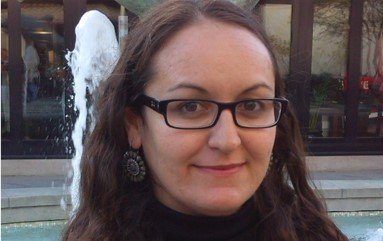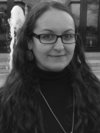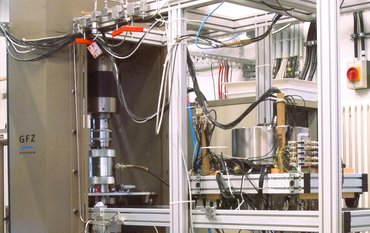Sanja Panovska, Postdoc in GFZ-Section 2.3 Geomagnetism, and her project partner Sabrina Sanchez recently from the Institut de Physique du Globe in Paris, won the 1.500 euros EGU Outreach Prize 2023. They are realising a booklet for kids with games and puzzles about different geoscience fields – from mineralogy to volcanology to Earth magnetism.
In an interview, Sanja Panovska gives insights into the project, her motivation and other outreach projects.
Congratulations, Sanja! That sounds like an interesting – and challenging – project. We are curious to learn more about it…
Thanks! Well, our project aims to promote Earth, planetary, and space sciences to children of about three to eight years – through a kid booklet. Through games, drawings, coloring, simple logical tasks, and puzzle solving, the children will learn about geosciences, the basic principles of the Earth system, and the processes involved. We work on covering as many different topics as possible, ranging from mineralogy, volcanology, paleontology, Earth magnetism and rock physics, atmosphere, natural hazards, seismology, and stratigraphy to planetary and solar systems sciences.
So, this seems to become quite a thick booklet…
For the moment, we have planned one game per page, about 30 altogether, but the final decision will be made after an initial evaluation. Most games will have speech bubbles containing tips or ‘do you want to know more’. For the children who are not reading yet, adults can help. And – very important: solutions will be presented at the end of the booklet in small boxes allowing the children to evaluate their work.
Can you give an example for such a game?
Yes, of course. It is inspired by those nice drawings you sometimes find in Nature articles to illustrate scientific publications for a broader public, for example about the effects of climate change: You could have two pictures like ‘before’ and ‘after’ where one should find the differences – like melting glaciers, rising sea level or erosion that changes the landscape.
You are realizing the booklet together with Sabrina Sanchez, a geoscientist from Paris. How did you meet?
We met when she was still working at MPI in Göttingen, also on geomagnetism. Sabrina is not only scientist but also a very talented artist. So, she will make the drawings. And I guess it is very good and comfortable to develop the design-part with someone who understands the science behind it well.
What was your motivation to plan such an outreach project for the youngest?
I am inspired by Nelson Mandela's quote: “Our children are the rock on which our future will be built, our greatest asset as a nation. They will be the leaders of our country, the creators of our national wealth, those who care for and protect our people”.
And as a mother of two young kids, I am constantly creating activities to keep them occupied while learning something new and developing their logical thinking. Some of the proposed games were motivated by these activities. I want to support the children in learning about the world around us and engage their curiosity and observational skills.
But of course, the booklet can be an inspiration not only to youngsters but also to others of all ages involved with the children. One example of where the booklet can be of great use is the childcare facility for children of meeting attendees, for example at EGU conferences.
This is not your first outreach-project, right?
You are right. I guess it is important to bring our science to a broader public. So I like to participate in outreach events like the Long Night of the Sciences here on Telegrafenberg, and during my PhD, I was volunteer in the exhibition of focusTerra, the Earth & Science Discovery Center of ETH Zürich.
Besides, I participated in two film projects: I was the narrator and one of the writers of the movie “Magnetic mosaic” submitted to the UNESCO Earth Futures Festival. Out of 972 entries in 7 categories and three themes, 21 films were selected as finalists. “Magnetic Mosaic” was one of the finalists in the category “Women in Earth Sciences”. The film combines interviews with 10 female scientists of different nationalities currently working at GFZ Potsdam and tells how the Earth's magnetic field can connect different dynamic parts that shape our planet.
And together with Sabrina and others, I was co-author on a project for science outreach to kids called “Bimbim's Team: A Journey to the Planets” funded by Europlanet Society. We worked on three cartoons with topics on the Solar System, Earth and Mars. The cartoons are available on the IAGA YouTube channel.
Do you think that engagement in outreach is sufficiently recognised in everyday academic life and in academic CVs?
In my opinion, public outreach is not valued enough. It is often considered a worthless time investment, partly because it is not adequately included in the researcher’s metrics considered for career development. However, I believe the situation is changing, and public outreach is seen as a positive asset in researchers' CVs.
What are the next steps for your booklet?
The project officially started in October and will last for one year. We are invited to present a first version of our work at next year’s EGU General Assembly in Vienna in April 2024 and to participate in EGU educational and outreach activities. We are also invited to submit a paper about our work to the journal Geoscience Communication. Therefore, we plan some systemic evaluation of a preliminary first version of the booklet: gain feedback from test-users – the parents of course – through a questionnaire and rating of the different puzzles.
When will the booklet be available?
We hope to finish it by October, 2024 – first in an English version, but we certainly will translate it to many languages. There will not be so much text in it, and we have already received many offers from colleagues all over the world who like the idea and would provide us with a German, French, Spanish, Chinese, Arab… version.
Will it be produced as a real booklet that you can buy?
We would like to have it as an actual booklet. But the limited funds will not allow that. Some copies will be printed and distributed for evaluation purposes, and the final version will be available online for downloading and self-printing. Our initial plan is not to sell the booklet, but we leave the door open for discussion.
We want to make the booklet available as widely as possible. So, we will provide a pdf-document on the EGU website for download. And then spread it through the EGU meeting, EGU website, via social media, outreach events, schools, or education institutions like our GFZ School lab.
We already look very much forward to seeing the children's booklet authored by female scientists – and mothers – to reach the children's hands.
So do we – thanks for the interview!
About
Dr. Sanja Panovska has been a postdoc scientist at GFZ since 2016, where she started with a re-entry position in Section 2.3 Geomagnetism. In 2019, she won a GFZ Discovery Fund Fellowship. Before joining the GFZ, she was Post Doc at the Scripps Institution of Oceanography, University of California San Diego (USA). She holds a PhD from ETH Zürich, and both, a Diploma in Geophysics and a Master of Engineering, from University Ss. Cyril and Methodius, Skopje (Republic of North Macedonia).
Interview: Uta Deffke









![[Translate to English:] Torsten Sachs in front of a climate station on a field](/fileadmin/_processed_/3/9/csm__TorstenSachs_bearbeitet_GS_4a1365ef84.jpeg)

![[Translate to English:] left image flood at the Ahrtal: image from above, several houses are flooded; left image:: Heidi Kreibich;](/fileadmin/_processed_/4/4/csm_Bild2_9af0130e9f.png)



![[Translate to English:] Start der Vega Rakete](/fileadmin/_processed_/6/4/csm_20231201-kachel_Vega-VV23-launch_ESA-CNES-Arianespace_706716b68c.jpeg)








![[Translate to English:] Poster exhibition at the Brandenburg Hydrogen Day at the GFZ, some participants in the foreground](/fileadmin/_processed_/6/5/csm_Erster_Brandenburgischer_Wasserstofftag_GFZ_402fcec95e.jpeg)
![[Translate to English:] Group picture of the participants](/fileadmin/_processed_/9/4/csm_20231108_CAWa-Workshop-Tashkent_Gruppenbild_99ea779d8a.jpeg)

![[Translate to English:] [Translate to English:] Hörsaal](/fileadmin/_processed_/e/6/csm_H%C3%B6rsal_e21ac645fb.jpeg)


![[Translate to English:] The Delegations in the Historic Library on the Telegrafenberg. In the back there are from left to right, the Dutch Ambassador for Germany, Ronald van Roeden, the Dutch Minister for Education, Culture and Science, Robbert Dijkgraaf and the scientific director of the GFZ, Susanne Buiter.](/fileadmin/_processed_/d/b/csm_Kachel-2_9eba4b4212.jpeg)


